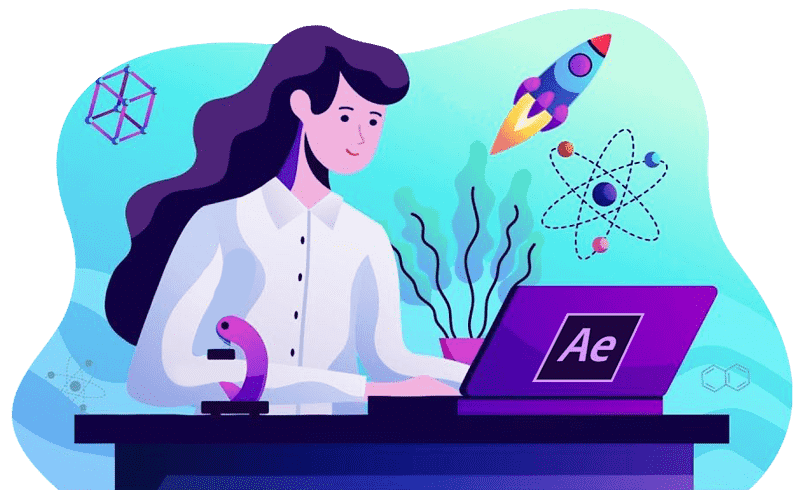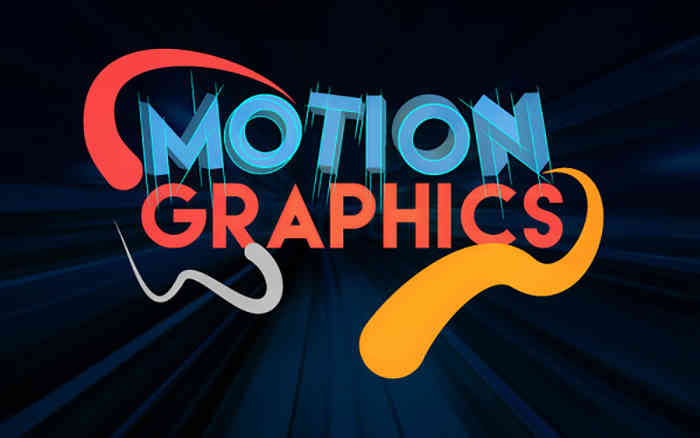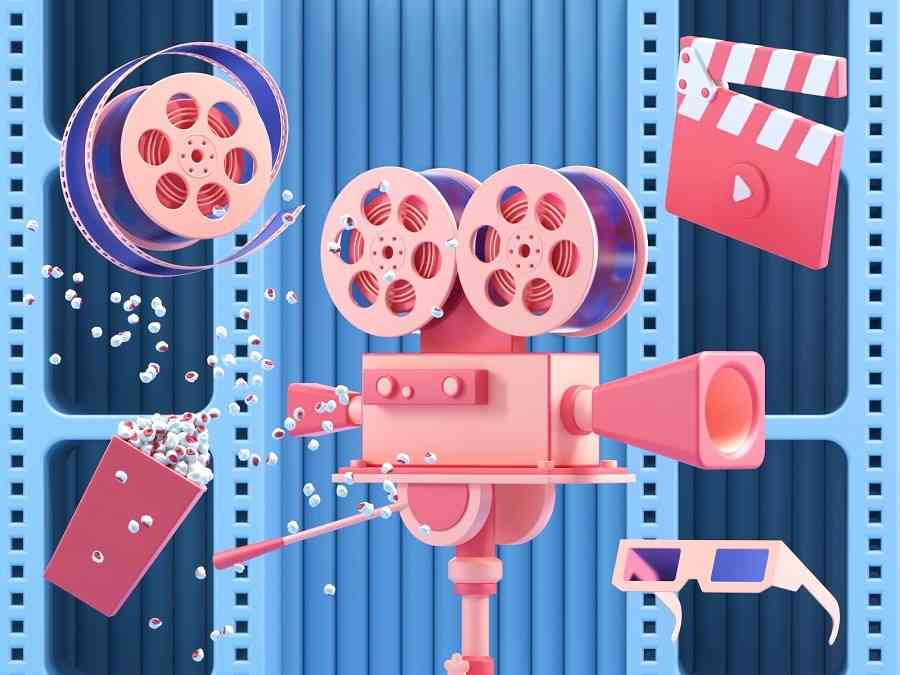Motion graphics training from beginner to advanced
Motion graphics training can always be at the top of your work steps if you are a beginner or a professional. Never stop learning and updating. In this educational article, we have tried to give simple explanations about motion graphics and advanced motion graphics training. In addition to beginners, people with previous knowledge can benefit from this training.

Applications of motion graphics
When you want to make a clip, you need a camera, lighting, sound recording, and actors, then video editing. But in motion graphics, you almost only have editing and sound, and the computer plays the rest of the roles. Therefore, it is logical that the cost of motion graphics is lower. On the other hand, motion graphics are much more attractive. Among the uses of motion graphics, we can mention the creation of advertising teasers, 2D animations, product or service introductions, advertising ideas, educational programs, etc.
Types of motion graphics
1. Motion graphics
The main motion graphics that you see and use are in this category. In this type of motion, graphics, images, and vectors are animated, and then sounding is done. Certainly, because it has sound, it is more attractive to the audience, and conveying concepts is done better.
2. Video motion
This motion graphics category combines real filming and graphics, and parts of the movie incapable of real filming are executed with graphics.
3. Stop motion
In this type of motion graphics, real objects are photographed; they move a little, take pictures, and then animate them.
4. Info Motion
First, the infographic is drawn, and now we insert the movement into the infographic to show the steps.
Stages of motion graphics production
1. First, the scenario or storyboard will be written for you, and your approval will be obtained.
2. Then, characters and locations will be shown to you to confirm.
3. Animation is done based on your scenario or storyboard.
4. Voicing is done based on the final scene.
Advantages of motion graphics
1. Transfer concepts in the best possible way.
2. It affects the audience.
3. Get into video marketing.
4. The cost is much lower than real teasers with filming.
5. It helps you a lot in social media marketing.
6. It greatly increases the quality of education.
Introduction
Always learning how to design motion graphics and learn how to make multiple elements in normal animation and simple and static ads can give a new spirit to work. Many tasks can be stimulated using the art of motion graphics. Among others, many static advertisements of websites, static presentations, and simple and static logos can be animated. Animating still images will create great appeal. Other simple and static banner ads can be animated with motion graphic art.
In the following, we will give explanations about motion graphics training and introduce its types in the following order:
- Teaching motion graphics and introducing its types
- Introduction of various types of motion graphics for learning motion graphics
- Introducing construction software in the discussion of advanced motion graphics education
- Psychological and instrumental skills of motion graphic artists
And in general, from personal and psychological skills to instrumental and software skills, this article will discuss.
Teaching motion graphics and introducing its types
In the discussion of motion graphics education, we should know that the main structure of the word motion graphics is made of two words motion plus graphics. Motion means movement, and graphics means visualization, the translation of both words together is moving visualization. Motion graphics are also called animated graphics. All or part of the image elements must be moving in motion graphics. Otherwise, it is not considered motion graphics.
There is a very beautiful and more accurate definition of motion graphics that says:
- Motion graphics is the use of imaging and design knowledge and temporal and spatial elements.
- When we want to talk about motion graphics, we may unconsciously compare it to animation. We may consider motion graphics as a part of it, and there are different opinions about it. Some consider motion graphics a part of the animation. Others have said that animation is a part of motion graphics and is considered a subset of it.
- But to clarify these opinions, the differences between the two can be stated. In motion graphics education, it is obligatory for everyone to distinguish between the two so that they know exactly what the difference between the two is.
- In learning motion graphics, it should be known that animations usually have various characters along with numerous long stories for each character. It is impossible to imagine an animation without a story and characters. Unlike animation, motion graphics can be characterless. Motion graphics can work with just a simple image and music.
Now, to clarify the matter, in the continuation of the motion graphics training, we will introduce the types of motion graphics:
Introduction of various types of motion graphics for learning motion graphics
To learn motion graphics, it is necessary to know its types. In the following, we have explained some types of motion graphics:
- Film and series titles are one of the most widely used types of motion graphics. Time and time again, motion graphics have been used at the beginning and end of movies, series, and even animations.
- Info motion is one of the other modes of motion graphics in which infographics have been converted into motion graphics. In this case, the strong visual and audio aspects will greatly impact the audience’s minds.
- Explaining videos are also part of motion graphics. Different moving images are broken from multiple places in them, and they introduce something to each other by placing the speaker’s visual and audio elements.
- Those looking for motion graphics training should know that UI animations are also considered as other motion graphics for advertising. They are very useful in introducing applications and sites. It is a simpler term to introduce the site and software. You can make your site and application guide with this type of motion graphics.
- In learning motion graphics, it should be known that moving logos are one of the other modes of motion graphics. If these logos are static and fixed, they are considered normal logos. If they are given movement, they will come to life and increase the attractiveness of the work.
- Presentations or presenters can also be motion graphics. They enhance the beauty of an educational or advertising presentation. They also make learning and conveying the message right.
Introducing construction software in the discussion of advanced motion graphics education
In discussing advanced motion graphics training, familiarity with software skills is very important, which we will introduce below. A lot of software helps in making motion graphics and makes the work of animation easier. Among the software that can be mentioned are Adobe After Effects software, Adobe Premiere Pro, Adobe Photoshop, Adobe Photoshop, and Adobe Illustrator, all of which are somehow part of motion graphics work. They can be helpful.
In the continuation of the motion graphics training, we will briefly introduce each one:
Adobe After Effects software
This software is one of the main software in the discussion of motion graphics training. Adobe After Effects software is one of the most powerful and main tools required in motion graphics creation. You cannot succeed in motion graphics without the necessary knowledge of this software. This software works with Photoshop and video layers simultaneously, and you can easily add images and videos to this software.
Adobe Premiere Pro Adobe Premiere Pro
This software is a tool for motion graphics based on the timeline. People can work together with audio and video using this software. They usually use this software for the final stages of graphic manipulation, editing, etc.
Adobe Photoshop Adobe Photoshop
Usually, designers must create their images and elements and create what they have developed using the software. At this stage, Photoshop is used, and it helps to make all elements of motion graphic design specially made and entered into other software such as Adobe After Effects.
Adobe Illustrator
Adobe Illustrator is also important for those looking for advanced motion graphics training, and like Photoshop, it is a tool for designing different image elements. The difference between this tool and tools like Photoshop is that Photoshop usually creates pixelated images. Still, this tool works with vectors, meaning changing sizes does not cause quality loss.

Psychological and instrumental skills of the motion graphic artist
As a person looking for motion graphics training, you need to have some psychological and instrumental skills to continue your work professionally and advance. In the following, some skills are listed in headings so that you can stay up-to-date on them; if you do not have any of them, you can learn and strengthen them.
- Knowing colors and understanding the psychology of colors
- Understanding the principles of animation and distinguishing the structure of animation and motion graphics
- Skills related to graphic design
- Understanding 3D space and familiarity with 3D software designs such as 3D etc
- Artistic skills such as storytelling, painting, screenwriting, etc., can help.
- Knowledge of typography, one of the most important skills in many advertising fields, can greatly impact inducing a sense of motion graphics message.


